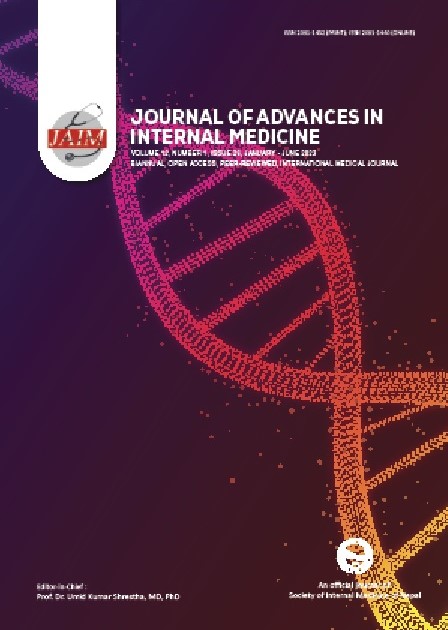A study on demographic and clinicopathological characteristics of severe acute pancreatitis in a tertiary-level intensive care unit in Nepal
DOI:
https://doi.org/10.3126/jaim.v12i1.56675Keywords:
Severe acute pancreatitis, Biliary, Epidemiology, Conservative management, OutcomeAbstract
BACKGROUND AND AIMS Severe acute pancreatitis can have serious consequences and a high mortality rate and may necessarily require intensive care unit admission. This study is to describe the demographic and clinicopathological characteristics of severe acute pancreatitis (SAP) in a tertiary-level intensive care unit (ICU).
METHODS The study was designed retrospectively with a diagnosis of severe acute pancreatitis (SAP) admitted to the tertiary-level adult ICU “between” January 2019 to December 2022.
RESULTS A total of 52 patients were enrolled in this study. The maximum numbers of patients were between 41 to 52 years of age, with a median age of 47.6 years. Gallstone (biliary) was identified as the most important etiological factor associated with severe acute pancreatitis. Among the known etiological factors, 52% of the cases were related to gallstone disease, 28.8% were due to alcohol, 7 (13.4%) to other causes (such as idiopathic, post-viral, post-ERCP, and drug-induced), and 5.7% were due to triglycerides. In our study, the most common symptoms were abdominal pain and vomiting. And the majority of patients recovered with conservative treatment. The majority 48 (92.3%) of patients improved, while 4 (7.6%) died. Eighteen (34.6%) patients required Mechanical ventilation (MV), while 10 (19%) with vasopressor supports. Eleven patients (21%) had evidence of an acute kidney injury on admission. Three patients (5.7%) underwent surgery, including necrosectomy and open cholecystectomy. The median length of ICU stay was 6.3 days.
CONCLUSIONS The most common cause of severe acute pancreatitis was gallstone, followed by alcohol-related. SAP was seen more commonly in the male gender in the age group of 41-52 years. The most common presenting symptoms were abdominal pain and vomiting. Most SAP cases could be managed conservatively.
Downloads
Downloads
Published
How to Cite
Issue
Section
License

This work is licensed under a Creative Commons Attribution 4.0 International License.
This license enables reusers to distribute, remix, adapt, and build upon the material in any medium or format, so long as attribution is given to the creator.




